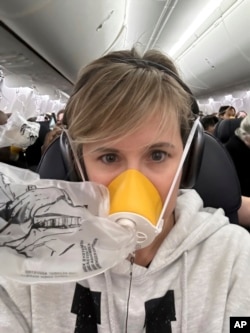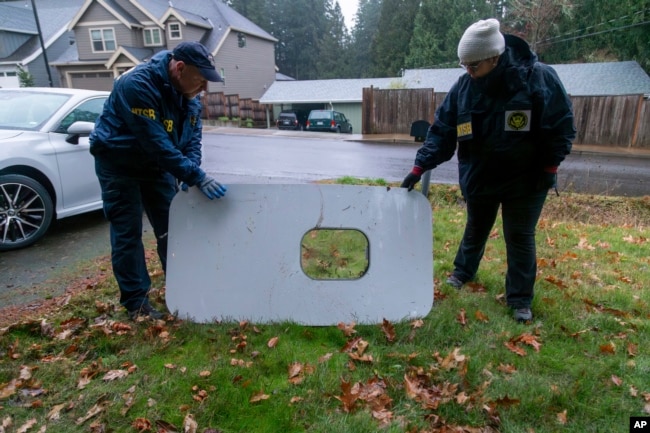AUDIO
Disaster in the Air Narrowly Avoided

Passengers are describing what happened when part of a passenger jet came off at the start of a flight from Portland, Oregon last Friday.
The incident resulted in no serious injuries, and the plane returned to Portland Airport soon after the dangerous incident. But had a few details been different, the flight could have ended in disaster.
Kelly Bartlett was one of the passengers on Alaska Airlines flight 1282 from Portland. She told The Associated Press (AP) that, at first, passengers did not know what was happening. “We didn’t know if it meant we were going to crash,” she said.

This image provided by Kelly Bartlett shows Bartlett wearing an oxygen mask on an Alaska Airlines Boeing 737 Max 9, Flight 1282 on Friday, Jan. 5, 2024. (Kelly Bartlett via AP)
The incident happened six minutes into the flight from Portland to Southern California’s Ontario International Airport. The jet, a Boeing 737 MAX 9, was traveling at about 640 kilometers an hour. It had reached an altitude of 4.8 kilometers. That detail is important. The plane was still far below its cruising altitude.
Flight attendants had just told the 171 passengers that they could again use their electronic devices. Then, a piece of the airplane body 61 centimeters by 122 centimeters behind the left wing blew out.
The piece called a door plug, was meant to be a cover over an emergency exit that was not used on that MAX 9 version of the airplane. The cover permits extra seats to be put where an emergency exit would be. Air safety rules require airliners to have enough exits to permit all passengers and crew to get out of the aircraft in 90 seconds.
The AP noted, as fate would have it, nobody was sitting in the two seats next to the blown-out hole.
Emergency oxygen masks dropped immediately. At the same time, wind rushed into the cabin making it difficult for the flight attendants to walk or hear. But they moved toward the hole and began moving passengers away from the dangerous area. The sound made communication difficult.
The force from the loss of pressure in the cabin was strong enough to tear the shirt off the body of a teenager sitting nearby.
His seatbelt “kept him in his seat and saved his life,” Bartlett said. Flight attendants moved the young person next to Bartlett. She asked him if he was hurt. He said he was OK and thanked her for her kindness.
The pilots and the flight attendants have not made public statements and their names have not been released. However, they spoke to National Transportation Safety Board (NTSB) investigators. They said they followed their training. The pilots’ goal was to get the plane back to Portland quickly. The flight attendants worked to keep the passengers safe and calm.
NTSB Chair Jennifer Homendy said the actions of the flight crew were “incredible.” Bartlett also praised the crew. She said she felt like the situation was under control.
The pilots used an emergency handbook next to the captain’s seat. The co-pilot contacted air traffic controllers declaring an emergency and the need to descend to 3,000 meters. The lower altitude would give passengers more oxygen to breathe.
Homendy said the attention of the flight attendants immediately turned to five children who were traveling without adult supervision and two babies being carried by their parents.

This photo released by the National Transportation Safety Board shows the door plug from Alaska Airlines Flight 1282 on Monday, Jan. 8, 2024, in Portland, Oregon. (National Transportation Safety Board via AP)
Evan Granger was sitting close to the hole in the plane. He told NBC News, “There were so many things that had to go right in order for all of us to survive.”
Homendy said that if the blowout had happened just a few minutes later when the plane would have reached its cruising height, the incident might have been a tragedy.
NTSB agents recovered the door plug that blew out, finding it completely intact. Many other things that flew out of the airplane were also recovered including a cellphone that was still working.
Now the agency will investigate why the cover over the unused exit hole came off.
The incident happened days after a Japan Airlines Airbus 350 struck a coast guard plane on a runway at Tokyo’s Haneda Airport and caught fire on January 3.
In that incident, four on the coast guard plane died. But 379 passengers and the crew of the airliner safely got out of the passenger plane before it burned up. However, reports say getting everyone out of the plane took about 18 minutes.
Words in This Story
altitude –n. the height of something above sea level
exit –n. a doorway out of a building or vehicle
as fate would have it –idiom meant to express that something happened that is beyond human explanation
oxygen mask –(industry) an emergency device on large airplanes that deploys if air pressure inside gets too low
cabin –n. (in aviation) the inside of an airplane
seatbelt –n. a thin piece of material that is meant to protect against injury in a crash
intact –adj. whole and in one piece, not broken or damaged
https://learningenglish.voanews.com/a/disaster-in-the-air-narrowly-avoided/7433082.html